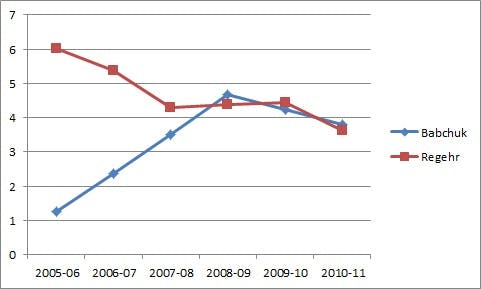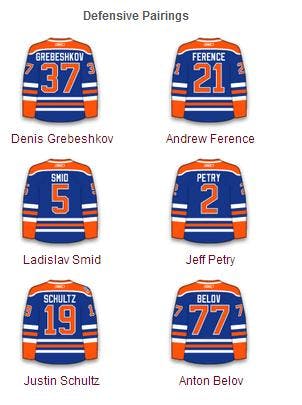Babchuk: Regehr’s Defensive Equal?
Last year, Anton Babchuk was not better defensively than Robyn Regehr. I really hope I haven’t blown the minds of anyone that watched even a single game, but that sentence is surprisingly controversial in the statistical community.
In this first of a two-part series I’m going to reveal the controversy, and explain exactly why there are statisticians who might lead you to believe that Babchuk is as effective at shutting down opponents as Regehr, then in part two I’ll try to offer up a solution.
Does Babchuk = Regehr?
First of all, if Anton Babchuk truly is as good or better defensively than Robyn Regehr, then someone should have told Calgary’s coaching staff, because they treated him like a major liability. They didn’t use Babchuk to kill penalties, they didn’t use him against top opponents, they didn’t use him in the defensive zone, and given his obvious advantage offensively, they didn’t even use him at even-strength nearly as often as he could have played, let alone as often as Regehr.
Babchuk Regehr
Even-Strength Ice-Time Per Game 12.98 17.23
Shorthanded Ice-Time Per Game 0.49 3.07
Power Play Ice-Time Per Game 2.47 0.24
Even-Strength Scoring Rate 1.07 0.57
Defensive Zone Starts 38.1% 50.1%
Quality of Competition -1.15 1.45The case couldn’t be clearer that, according to the Calgary Flames coaching staff, Anton Babchuk was significantly inferior defensively relative to their other options, especially Robyn Regehr.
The Controversy
So where’s the controversy? Well according to most high-level defensive statistics, Anton Babchuk was seen as being equivalent to Robyn Regehr defensively, most likely as a consequence of his +18 plus/minus rating, and the inability of opponents to score while he was on the ice, which is an understandable consequence of playing in the offensive zone against weak competition.
Check out Anton Babchuk vs Robyn Regehr using the Defensive Point Shares (DPS) system used at Hockey-Reference.com (explained here). Heck, look at all their defensemen for the 2010-11 season.
Defenseman GP DPS DPS/GP Anton Babchuk 65 3.5 0.054 Jay Bouwmeester 82 4.0 0.049 Cory Sarich 76 3.6 0.047 Robyn Regehr 79 3.5 0.044 Steve Staios 39 1.6 0.041 Adam Pardy 30 1.1 0.037 Mark Giordano 82 3.0 0.037 Brendan Mikkelson 19 0.1 0.005 Ian White 16 -0.2 -0.013 Minimum 10 GP
Apparently Anton Babchuk was Calgary’s best defensively option, and it wasn’t just a single-season fluke, because a quick look at their defensive point shares since the lock-out, adjusted to 82 games and with Babchuk’s missing KHL seasons filled as midway points, it looks like Babchuk and Regehr have been equivalent defensively for a while now.

So there’s 30 seconds left, the Calgary Flames are sitting on a one-goal lead, and apparently Anton Babchuk should line up alongside Jay Bouwmeester! We don’t really mean to pick on Justin at Hockey-Reference, because similar systems, like Corsi, Tom Awad’s GVT (explained here), Alan Ryder’s PC (explained here) and WhatIfSport’s defensive measurement all lead to similar conclusions.
Babchuk Regehr
Plus/Minus +18 +2
Relative Corsi 3.1 -3.6
Defensive Point Shares 3.5 3.5
Defensive GVT 4.5 6.2
Defensive PC 38.3 40.3
WhatifSports Defense 79 59Are you kidding me? This is the sort of thing that gets many fans to say statistical hockey analysis is complete nonsense (except using less kind language). And who can blame them? What are we supposed to say – here are more statistics to put it into context? You don’t trust something, so we give you more of them, and that’s supposed to increase your trust level?
What Went Wrong
To me the deeper question is to figure out what these approaches are doing, and how to adjust them appropriately to avoid results like these. In each case they’re basically doing two things:
1. Figure out how effective the entire team is defensively (i.e. at goal prevention).
2. Assign that effectiveness among the individual players in a proportional fashion.
2. Assign that effectiveness among the individual players in a proportional fashion.
There doesn’t appear to be anything fundamentally wrong with the first step, especially since we’re comparing two players on the very same team. Nevertheless I did a quick verification as follows:
1. Identified the worst defensive team since shots were counted, the 1992-93 San Jose Sharks. They allowed 3075 shots in 84 games, or 3002 if it had been 82 games.
2. Calculated how many goals they would have allowed each season using modern-day average save percentages (shots multiplied by league average save percentage).
3. Repeated step 2, but for the Calgary Flames (to remove Miikka Kiprusoff’s influence on goals allowed).
4. Looked at the difference between the two, which should be the number of goals the Calgary Flames prevented as a team, relative to the worst possible team you could dress.
2. Calculated how many goals they would have allowed each season using modern-day average save percentages (shots multiplied by league average save percentage).
3. Repeated step 2, but for the Calgary Flames (to remove Miikka Kiprusoff’s influence on goals allowed).
4. Looked at the difference between the two, which should be the number of goals the Calgary Flames prevented as a team, relative to the worst possible team you could dress.
Comparing my results (which were never meant to be perfect) with Hockey-Reference for every year since the lock-out and not only does theirs make sense, it actually looks even smoother and better.

While both systems agree the Flames peaked defensively in 2005-06 and have been reasonably constant since then, Hockey-Reference saw a big jump in 2009-10 – which makes perfect sense, assuming the Calgary Flames deserve some credit for Miikka Kiprusoff’s .920 save percentage (it was .903 the year before and .906 the year after).
Next Time
Given that the process to figure out how good teams are defensively seems to make sense, obviously the flaw must be in how everybody’s share of that defense is being assigned.
Having explained the controversy of how so many mainstream measurements claim that Anton Babchuk is as good defensively as Robyn Regehr, having explained why that’s completely mistaken, and finally having established that the team-based defensive evaluation is at the very least reasonable, all that remains next week is to explain how the individual assignments of that team-level defense is flawed, and how it might be corrected.
Recent articles from Robert Vollman




